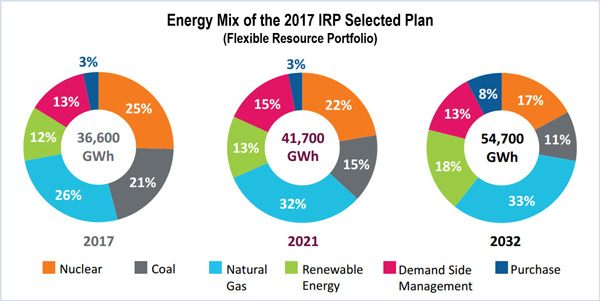By Robert Mullin
Arizona Public Service expects to meet its future energy needs through increased use of natural gas, solar and efficiency measures, while at the same time reducing its reliance on coal-fired generation, according to the company’s 15-year integrated resource plan.
The IRP filed with the Arizona Corporation Commission predicts the utility will face a deepening “duck curve” — such as that already witnessed in California — as households within its service territory ramp up adoption of non-curtailable rooftop solar resources.
Still, APS sees a continued, if reduced, role for its 1,146-MW Palo Verde nuclear plant located near Phoenix, which the company refers to as the country’s “largest carbon-free resource.”
The IRP calls for APS to rely on solar resources and energy efficiency to meet 50% of projected demand growth in its service territory by 2032, when the utility’s peak capacity requirements are expected to reach 13,000 MW, a 61% increase from the current 8,086 MW. The plan assumes that Arizona’s population will grow to more than 9 million from around 6.9 million today, adding 550,000 customers to the utility’s service area. The state’s Office of Economic Opportunity population projection falls short of APS’ 2032 estimate at just less than 8.8 million.
“We do have some concerns with [APS’s] numbers, but haven’t come to any conclusions yet,” Ken Wilson, an engineering fellow with Western Resource Advocates, told RTO Insider. Wilson noted that he’s participated in several preliminary workshops in which the utility presented its projections for load growth.
To achieve its goal of using renewables and efficiency to address half of that expected future growth, APS has proposed what it calls a “flexible resource portfolio,” that reduces carbon emissions through “select coal reductions,” more demand-side management and “a prudent level of energy storage,” while continuing to add renewables and operate Palo Verde.
Over the planning period, natural gas generation is expected to increase from 26% to 33% of the utility’s energy mix, while utility-scale renewables grow from 12% to 18%.
The utility also expects to offset peak load with an additional 979 MW of demand-side resources, which includes demand response and energy efficiency.
Coal-fired capacity would decline by 702 MW (42%) to 970 MW, accounting for 11% of the energy mix, down from 21% today. Output from Palo Verde is slated to hold steady, but the plant’s share of the mix would drop from 25% to 17%.
Market purchases are forecast to rise from 3% to 8% as the company retires coal and rolls off existing power contracts.
“APS will continue to pursue opportunities to increase operating efficiency and save customers money, such as participating in the CAISO Energy Imbalance Market and purchasing excess energy from short-term markets at low or negative (i.e., paid to take) prices,” the company said in a statement.
APS estimates that its CO2 emissions and water consumption per unit of electricity will decline by 23% and 29%, respectively.
“Overall, our energy mix is increasingly cleaner, and we are adding more quick-starting power sources to integrate our growing solar energy resources and emerging technologies,” said Tammy McLeod, APS vice president of resource management.
Key among those technologies is energy storage, the deployment of which is expected to climb from 4 MW to 507 MW over the next 15 years.
The IRP points to the adoption of rooftop solar as “one of the single most defining factors in western energy markets today,” given its tendency to displace the output of other resources, create volatility in wholesale power prices and increase the need for fast-ramping natural gas plants and resources serving local load pockets.
APS expects rooftop installations within its territory to nearly double by 2032 to 4,998 MW, precipitating a deepening of a duck curve that could push “net loads” — the portion of system load served by non-variable resources — to as low as 500 MW, which will create ramping requirements of between 4,000 and 5,000 MW.
In response, the company plans to upgrade its operational flexibility, including the modernization of its Ocotillo Power Plant with five quick-start natural gas-fired units. APS also plans to invest in technologies that increase real-time visibility into the utility’s distribution system and implement a new Demand Response, Energy Storage, Load Management program to help residential customers manage energy use.
“Increasing renewable resources, energy efficiency and energy technologies, supported with highly responsive resources such as natural gas generation, will enable APS to deliver cleaner, reliable and reasonably priced electricity,” McLeod said.





